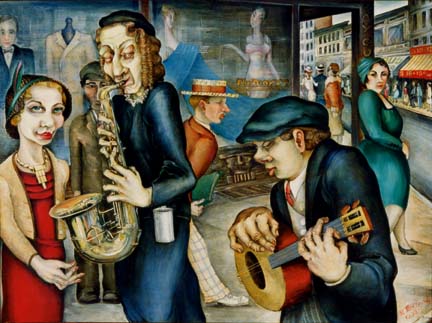Richard Kollorsz
1900-1983
Richard Kollorsz was born near Breslau, Germany in 1900. His father
and his brother Franz were artists.
Kollorsz studied at the Academy of Art in Breslau, and after World War
I he attended the Kunstakademie in Dresden; where he stayed for seven
years.
The German academies of this period taught traditional techniques, but
also the young artist were exposed to the “New Realism”
in German painting. He won a scholarship to study in Rome, and after
a period of study and exploration he returned to Dresden.
The turning point in his education came when he entered the master class
of Otto Dix, one of the most important proponents of the new direction
in German Realism. Kollorsz was well received by Dix and later directed
his master class.
Kollorsz, in 1929, traveled to the United States, where he was to begin
a long career as an art director in Hollywood movies. We became acquainted
with, and a protégé of Josef Von Sternberg. Von Sternberg
was a successful film director, he directed Marlene Dietrich in many
films in the 1920s and 1930s. Kollorsz became Von Sternberg’s
principal set director.
Von Sternberg was an avid art collector; no doubt Kollorsz had significant
input in his collecting. Among Von Sternberg’s collection were
several works by Kollorsz.
From the time Kollorsz arrived in Los Angeles and pursued his career
in films, he did not often exhibit his paintings. He was not involved
in the artistic community of Los Angeles. In 1932 he worked with Siquerios
on a mural on Olivera Street, and with his friends in the film industry
he helped Siquerios come to the attention of the Los Angeles community.
Also in 1932 he loaned his painting “Street Musicians” to
an exhibition at the Palace of the Legion of Honor in San Francisco.
In the early 1930s Von Sternberg sponsored an exhibition at the Plaza
Art Center on Olivera Street in Los Angeles, the exhibit was to call
attention to the work of Kollorsz and Peter Ballbusch.
The early paintings of Kollorsz employed a technique not often seen
in paintings created in the United States, he used oil glaze over tempera,
a time consuming process. The method is rooted in a tradition of German
paintings of Holbein and Durer. This technique lent itself to extraordinary
realism, rich colors, and exquisite detail. The subjects of his early
paintings show the strong influence of Otto Dix, and they express the
desperation of the German Realists.
Though Kollorsz did not exhibit, he continued to paint for many years;
his early style of German Realism gave way a more Postimpressionist
method. His subjects remained the human form and human condition, but
lighter and more cheerful. He also painted many watercolors of the beaches,
of workers, cityscapes, and nudes, typical of his generation of American
Scene painters.
|

